These NCERT Solutions for Class 7 Science Chapter 8 Winds, Storms and Cyclones Questions and Answers are prepared by our highly skilled subject experts to help students while preparing for their exams.
Winds, Storms and Cyclones NCERT Solutions for Class 7 Science Chapter 8
Class 7 Science Chapter 8 Winds, Storms and Cyclones Textbook Exercise Questions and Answers
Question 1.
Fill the missing word in the blank spaces in the following statements:
a. Wind is ……………… air.
b. Winds are generated due to ……………… heating on the earth.
c. Near the earth’s surface ……………… air rises up whereas ……………… air comes down.
d. Air moves from a region of ……………… pressure to a region of ……………… pressure.
Answer:
a. moving
b. uneven
c. warm, cooler
d. high, low
Question 2.
Suggest two methods to find out wind direction at a given place.
Answer:
Two methods to find the direction of wind are:
- Take a handful of sand or dust. Release it slowly from a height and observe the direction in which the falling sand is moving. This will show the direction of wind.
- Tie a thin plastic sheet or cloth with a stick. Keep the stick at a place which is as high as possible. The direction in which the cloth sways shows the direction of wind.
Question 3.
State two experiences that made you think that air exerts pressure (other than those given in the text).
Answer:
- A parachute helps the people in reaching the ground safely. The air pressure reduces the speed of the parachute and the paratrooper lands without getting injured.
- Ink can be filled in a fountain pen with the help of atmospheric pressure. When the tube of the pen is squeezed, the air in it rushes out so that the pressure in the tube decreases. The air pressure outside the tube now pushes the ink into the pen.
Question 4.
You want to buy a house. Would you like to buy a house having windows but no ventilators? Explain your answer.
Answer:
No, a house should have ventilators along with windows. This is because the warm air would rise up and exit from the ventilators. The cooler air would rush in through the windows. This will help in making the rooms comfortable. A room without ventilators shall not be cooled as efficiently as the one with ventilators.
![]()
Question 5.
Explain why holes are made in hanging banners and hoardings.
Answer:
Banners and hoardings are usually very large. The air pressure because of the moving air can blow away the banners. Holes are made in banners and hoardings so that the wind can move through them. This helps in reducing the impact of air pressure on the hoardings and thus they are not blown away.
Question 6.
How will you help your neighbours in case cyclone approaches your village/ town?
Answer:
We will take following steps to help our neighbours in case of cyclone:
- We will help them to shift to a safer place.
- We will organise a community kitchen during the stress period.
- We will provide first aid to injured people.
- We will also arrange for safe drinking water for the people.
- We will built temporary safe shelter for them.
Question 7.
What planning is required in advance to deal with the situation created by a cyclone?
Answer:
Following planning is required to deal with the situation created by a cyclone:
- Proper shelters should be built by the government agencies so that people can be accommodated in them.
- Alternate arrangements of seamless communication among rescue agencies should be made.
- Proper stock of emergency medicines should be kept.
- Proper arrangements of safe drinking water should be made.
- Government should chalk out a rehabilitation plan for those affected by cyclone.
Question 8.
Which one of the following place is unlikely to be affected by a cyclone?
(a) Chennai
(b) Mangaluru (Mangalore)
(c) Amritsar
(d) Puri
Answer:
(c) Amritsar
Question 9.
Which of the statements given below is correct?
a. In winter the winds flow from the land to the ocean.
b. In summer the winds flow from the land towards the ocean.
c. A cyclone is formed by a very high-pressure system with very highspeed winds revolving around it.
d. The coastline of India is not vulnerable to cyclones.
Answer:
a. In winter the winds flow from the land to the ocean.
NCERT Extended Learning Activities and Projects
Question 1.
You can perform the Activity 8.5 (of NCERT textbook) in the chapter slight differently at home. Use two plastic bottles of the same size. Stretch one balloon on the neck of each bottle. Keep one bottle in the sun and the other in the shade. Record your observations. Compare these observations and the result with those of Activity 8.5 (of NCERT textbook).
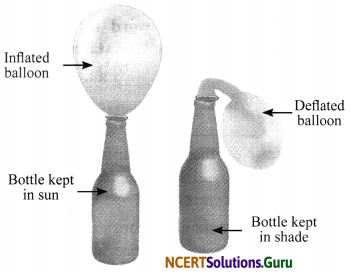
Hint:
The balloon kept in the sun will become slightly inflated as the air is hot in sun. However, the balloon in shade will contract as the air is cooler.
![]()
Question 2.
You can make your own anemometer. Collect the following items: 4 small paper cups (used ice cream cups), 2 strips of cardboard (20 cm long and 2 cm wide), gum, stapler, a sketch pen and a sharpened pencil with eraser at one end.
Take a scale; draw cross on the cardboard strips as shown in the figure. This will give you the centres of the strip.
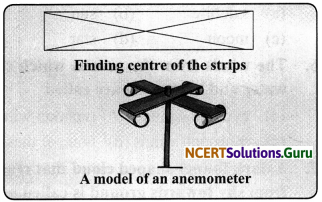
Fix the strip at the centre, putting one over the other so that they make a plus (+) sign. Now fix the cup at the end of the strips. Colour the outer surface of one cup with a marker or a sketch pen. All the four cups should face in the same direction.
Push a pin through the centre of the strips and attach the strips and the cup to the eraser of the pencil. Check that strips rotate freely when you blow air on the cups. Your anemometer is ready. Counting the number of rotations per minute will give you an estimate of the speed of the wind. To observe the changes in the wind speed, use it at different places and at different times of the day. If you do not have a pencil with attached eraser you can use the tip of a ball pen. The only condition is that the strips should rotate freely.
Remember that this anemometer will indicate only speed changes. It will not give you the actual wind speed.
Hint:
Do it yourself with the help of the process suggested in the question.
Question 3.
Collect articles and photographs from newspapers and magazines about storm and cyclone. Make a story on the basis of what you learnt in this chapter and the matter collected by you.
Hint:
Do it yourself.
Question 4.
Suppose you are a member of a committee, which is responsible for creating development plan of a costal state. Prepare a short speech indicating the measures to be taken to reduce the suffering of the people caused by cyclones.
Hint:
As concerned members of a development plan committee, it is important that we must take proper precautions in advance to reduce the suffering and devastation to a great limit. The warning must be issued in advance and people must stay away from the sea. They must keep essential commodities with them and must move to safer places in advance. Water, medicines, food, etc., must be kept in handy to handle the difficult situation in future. They should be requested to keep ready the phone number of emergency services like police, fire brigade and medical centres, etc.
Question 5.
Interview eyewitness to collect the actual experience of people affected by a cyclone.
Hint:
Do it yourself.
Question 6.
Take an aluminium tube about 15 cm long and 1 to 1.5 cm in diameter. Cut slice of a medium-sized potato about 2 cm thick. Insert the tube in the slice, press it, and rotate it 2-3 times. Remove the tube. You will find a piece of potato fixed in the tube like a piston head. Repeat the same process with the other end of the tube. Now you have the tube with both ends closed by potato pieces with an air column in between. Take a pencil with one end unsharpened. Place this end at one of the pieces of potato. Press it suddenly to push the potato piece in the tube. Observe what happens. The activity shows rather dramatically how increased air pressure can push things.
Caution: When you perform this activity, make sure that nobody is standing in front of the tube.

Hint:
You will observe that the potato piece on the other side of the tube is blown away. This happens because the air inside the tube exerted pressure on the potato piece.
![]()
Activity 1
Objective: To show that high speed winds are accompanied by reduced pressure.
Materials Required: An empty bottle and a piece of paper.
Procedure:
- Crumble a small piece of paper into a ball of size smaller than the mouth of an empty bottle.
- Hold the empty bottle on its side and place the paper ball just inside its mouth.
- Now try to blow on the ball to force it into the bottle.
- Now repeat the activity with bottles of different sizes.
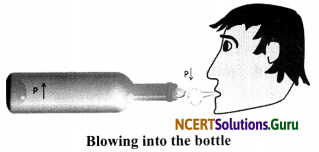
Observation: It is very difficult to force the paper ball into the bottle. In most cases, the ball falls out of the bottle.
Conclusion: Since the pressure inside the bottle become higher than that outside the bottle when air is blown, the paper ball doesn’t go inside. In fact, the ball comes out of the bottle.
Activity 2
Objective: To show that high speed wind causes low pressure.
Materials Required: Two balloons of approximately equal size, water, a rod and a string.
Procedure:
- Take two balloons of approximately equal size.
- Put a little water in the balloons.
- Blow up both the balloons and tie each one to a string.
- Hang the balloons 8-10 cm apart on a cycle spoke or a stick.
- Blow in the space between the balloons.
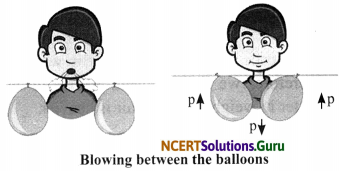
Observation: The balloons move inwards towards each other when air is blown between them.
Conclusion: Since the pressure at the outer parts of the balloons is higher than in between them, the balloons move towards each other.
![]()
Activity 3
Objective: To show that moving air can provide lift.
Materials Required: A strip of paper.
Procedure:
- Take a strip of paper. Hold one end of it. The other end drops down due to gravity.
- Now place it close to your mouth and blow on top of it.
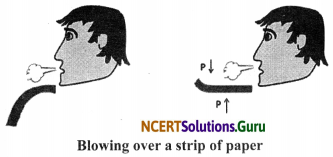
Observation: The paper is pushed up.
Conclusion: High speed air reduces pressure above paper strip, so the strip moves up from high pressure area to low pressure area. Hence, moving air can provide lift.
Hot Air and Cold Air: When the air is heated, it expands. As a result, it occupies more space and becomes lighter in weight. Therefore, we can say that warm air is lighter in weight and cold air is heavier.
Activity 4
Objective: To demonstrate that warm air is lighter than cold air.
Materials Required: Two paper cups of same size, a metal or a wooden stick, a piece of thread and a candle.
Procedure:
- Take two paper cups of the same size.
- Hang the two cups in the inverted position at the two ends of a metal or a wooden stick.
- Tie a piece of thread in the middle of the stick.
- Hold the stick by the thread.
- Put a burning candle below one of the cups as shown in the figure and observe.
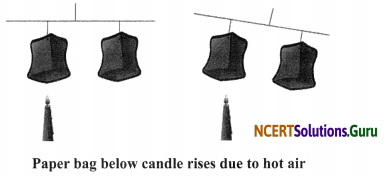
Observation: Hot air from candle goes inside one of the paper bags. The other bag has normal air. The bag above the candle flame rises higher.
Conclusion: Hot air, being lighter than normal air, moves up and takes the paper bag up with it. The other bag has cooler air, hence it goes down.
Warm air rises up, whereas comparatively cooler air tends to move towards the earth’s surface. When warm air rises up, air pressure at that place is reduced and the cooler air moves in to that place.
Generation of Wind Currents Due to Uneven Heating on the Earth: There are two situations where winds are generated on the earth:
i. Uneven heating between the equator and poles causes the north-south winds. The equatorial regions receive maximum sunlight and are hence warm. The hot air from equator rises up and a cooler air from 0°-30° latitude on either sides of the equator moves in. Similarly, polar air is cooler than air in about 60° latitude. Hence, cool air moves from poles towards warmer latitudes. These air currents tend to change direction because of the rotation of the earth.
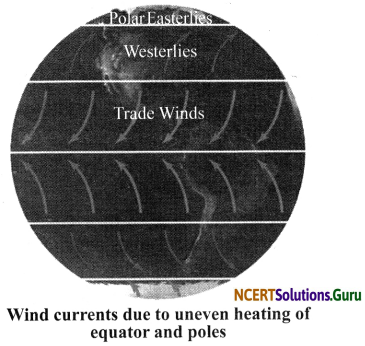
ii. Uneven heating of land and water causes monsoon winds on the earth which bring rainfall. Land gets heated up and cooled down faster than water. Hence, air over the land gets heated in summer and rises while cold air from oceans rushes towards land. These are monsoon winds.
Monsoon Winds: The flow of moist air from oceans towards land in summer is called monsoon or monsoon wind. The term ‘Monsoon’ had traditionally been used to describe the typical climate of the Indian Peninsula during the rainy season. Nowadays, the term ‘Monsoon’ is also being used to describe the similar climate in other parts of the world. Monsoon winds carry water vapour which falls over the land in the form of rain after cooling down. In India, the harvest depends on the monsoon wind because it is the major factor for bringing rainfall in India.
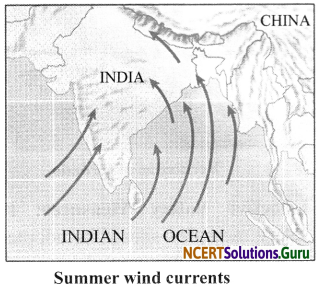
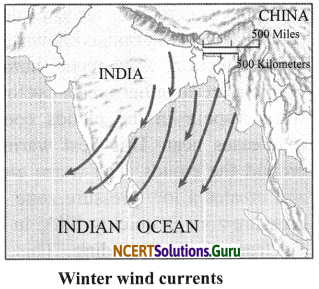
Thunderstorm: Thunderstorm occurs frequently in hot and humid tropical areas, such as India. In summer, the air rises up along with lot of moisture. After rising up to a certain height, water vapour cools down and starts coming down in the form of water droplets. The swift drifting of water droplets along with rising air creates electric charge among clouds. This manifests in the form of lightning and sound. This is known as thunderstorm.
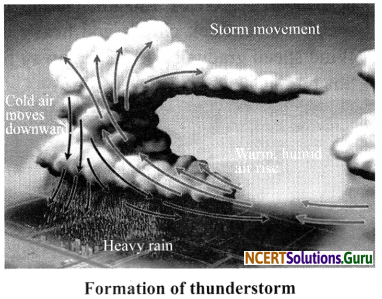
Precautions during a thunderstorm:
- Do not lie on the ground or take shelter under a tall tree.
- Do not carry umbrella with metallic end.
- Do not sit near a window.
- Do not stay inside water bodies.
- Do not take shelter in open garages, storage sheds, metal sheds, etc.
Cyclone: Fast moving air towards a centre, usually with heavy rain, is known as cyclone. Wind direction, wind speed, humidity and temperature together create cyclone. When water vapour in the clouds cools down, it releases heat. This heat warms the air around the clouds. The warm air rises up and creates a low pressure zone. This low pressure zone is quickly filled in by cooler air from the surrounding. This creates a system in which the centre is having very low pressure and is surrounded by high speed winds moving around it. The wind from the surroundings moves in a circular fashion towards the centre and gives rise to cyclone. In this way, a thunderstorm can manifest itself into a cyclone.
Structure of a cyclone: Cyclone is about 10-15 km high. Its centre is a calm area and is called the eye. The diameter of the eye varies from 10-30 km and it is free of clouds with light winds. Around eye, there is a cloud region of 150 km having high speed winds, thick clouds and heavy rain. Wind speed gradually decreases away from this region.
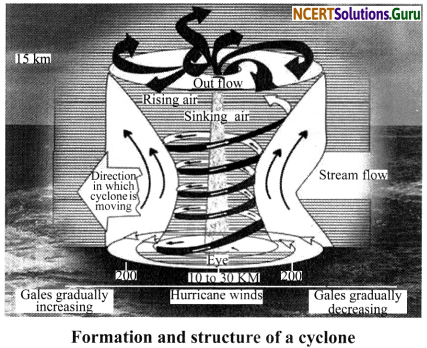
The formation of a cyclone depends upon different factors:
- The temperature of the place
- The wind speed
- The direction of the winds
- The humidity of the place
Tropical cyclones are also called Hurricane in USA and Typhoon in Japan and Philippines.
Destruction caused by Cyclones: It pushes huge water waves towards the land, as high as 3-12 m. Hence, sea water floods the coastal areas causing loss of life and property. Soil also becomes infertile due to seawater. Houses are damaged and communication systems are destructed.
Tornado: A tornado is a violently rotating dark funnel shaped cloud that reaches from the sky towards the ground. Diameter of a tornado ranges from few metres to a km. It grows bigger by taking dust and anything else near its base because of low pressure. Smaller tornadoes can only make dust rotate with itself whereas a bigger tornado can take vehicles or even houses. Precautions: During tornado, shut all windows, take shelter under a table, bench, etc. Take safety position by bowing down on knee and protecting head and neck. A tornado shelter is an underground room with no windows.
Precautions: During tornado, shut all windows, take shelter under a table, bench, etc. Take safety position by bowing down on knee and protecting head and neck. A tornado shelter is an underground room with no windows.
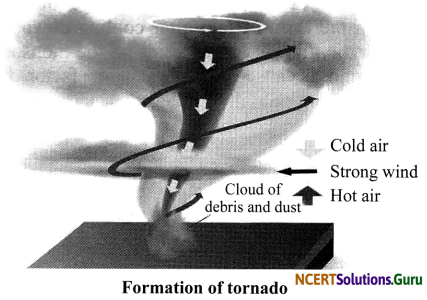
Effective Safety Measures: Following safety measures should be adopted in case of a thunderstorm or cyclone.
i. On part of the government:
- With help of satellites and radars, a cyclone alert or cyclone watch is issued 48 hours in advance of any storm.
- A cyclone warming is issued 24 hours in advance.
- Rapid communication of warnings is done to the government agencies, ports, fishermen, ships and general public.
- Cyclone shelters are constructed in cyclone-prone areas.
ii. On part of the people:
- Avoid driving on roads through standing water.
- Keep the phone numbers of all emergency services like police, fire brigade, etc., ready.
- Do not drink water that could be contaminated.
- Do not touch wet switches and fallen power lines.
- Cooperate with your neighbours, friends and rescue force.
Class 7 Science Chapter 8 Winds, Storms and Cyclones Additional Important Questions and Answers
Very Short Answer Type Questions
Question 1.
What is wind?
Answer:
The moving air is called wind.
Question 2.
Does air exert pressure?
Answer:
Yes, air exerts pressure.
Question 3.
Name the instrument which measures the wind velocity.
Answer:
Anemometer.
![]()
Question 4.
From which word is the term monsoon derived?
Answer:
The word monsoon is derived from the Arabic word mausam which means season.
Question 5.
What are the other names of cyclones?
Answer:
Hurricane and Typhoon.
Question 6.
What is tornado?
Answer:
A dark funnel shaped cloud that reaches from the sky to the ground is called tornado.
Question 7.
What is a wind storm?
Answer:
A wind storm is just a storm with high speed violent winds but with little or no rain.
Question 8.
What is hurricane?
Answer:
Tropical cyclones are also called Hurricane in USA.
Question 9.
What is air?
Answer:
Air is a mixture of gases.
![]()
Question 10.
What is thunderstorm?
Answer:
Many a times, rain is associated with lightning and roaring sound. Rain with lightning is called thunderstorm.
Question 11.
What are cyclones?
Answer:
The weather condition of formation of a very low pressure system with very high speed winds revolving around it, accompanied by heavy rain is called a cyclone.
Question 12.
What are the two technologies which help in making the forecast of a cyclone?
Answer:
Satellites and radars.
Question 13.
Which factor increases the speed of wind?
Answer:
Reduction of air pressure increases wind speed.
Question 14.
What is wind vane?
Answer:
An instrument used to find the direction of the wind is called wind vane.
Question 15.
Which area of a cyclone is calm, free of clouds and has only light winds?
Answer:
Centre of the cyclone called the eye of cyclone.
Question 16.
In which direction does air exert maximum pressure?
Answer:
Air exerts pressure equally in all directions.
![]()
Question 17.
What happens to the air, when temperature is increased?
Answer:
On heating, the air expands and becomes lighter.
Question 18.
What are the factors which contribute to the development of cyclones?
Answer:
Wind speed, wind direction, temperature and humidity contribute to the development of cyclones.
Question 19.
Why is warm air lighter than cold air?
Answer:
Air expands on heating. Due to expansion, air occupies more space (volume). As a result, density decreases and it becomes lighter. Thus warm air is lighter than the cold air.
Short Answer Type Questions
Question 1.
What causes lightning during a thunderstorm?
Answer:
Static electricity or charge is produced due to the collisions between water droplets and ice crystals in the atmosphere. This causes huge sparks between clouds or between a cloud and the ground in the form of lightning during a thunderstorm.
Question 2.
Describe the ‘eye of a cyclone’.
Answer:
At the centre of the cyclonic storm is a calm, cloudless area. This is called the eye. Its diameter may vary from 10 km to 30 km. There is no rain here and the winds are fairly light.
![]()
Question 3.
Explain why a rubber sucker pressed on a smooth surface gets stuck to it.
Answer:
Rubber sucker when pressed against a flat smooth surface, forces air between the smooth surface and the sucker out. This reduces air pressure in the space between the sucker and the smooth surface. There is greater air pressure outside. Hence, this outside air pressure firmly presses the rubber sucker to the smooth surface and it gets stuck.
Question 4.
A child blows air with a straw near the opening of another straw which has its other end in a soft drink bottle. What do you think will happen and why?
Answer:
The level of soft drink will rise in the bottle. This will happen because the air pressure is reduced above the straw and hence the drink will rise in it due to a greater air pressure inside.
Question 5.
Explain why smoke and hot air balloon always rises up.
Answer:
Smoke goes up because it is lighter than air. In the case of smoke, it’s density is less than that of the surrounding air and thus it rises. The same goes for a hot air balloon. The density of the hot air trapped inside a balloon is less than that of the surrounding cooler air and hence it makes the balloon rise.
Question 6.
What is thunderstorm? How does it develop?
Answer:
In summer, the air rises up along with lot of moisture. After rising up to a certain height, water vapour cools down and starts coming down in the form of water droplets. The swift drifting of water droplets and rising air creates electricity among clouds. This manifests in the form of lightning and sound. This is known as thunderstorm.
Question 7.
Which regions of India are vulnerable to cyclones?
Answer:
The whole coastline of India is vulnerable to cyclones, particularly the eastern coast. The west coast of India is less vulnerable to cyclonic storms both in terms of intensity and frequency of the cyclones.
![]()
Question 8.
How does air move?
Answer:
Air moves because of difference in air pressure. Air moves from the region where the air pressure is high to the region where the pressure is low. The greater the difference in pressure, the faster the air moves. Also, pressure variation occurs in air due to uneven heating in different regions.
Question 9.
List some effective safety measures that should be taken by the government for dealing with cyclone.
Answer:
Some effective safety measures are:
- A cyclone forecast and warning service.
- Rapid communication of warnings to the government agencies, the ports, fishermen, ships and to the general public.
- Construction of cyclone shelters and administrative arrangements for moving people to safer places.
Question 10.
What are the destructions caused by cyclones?
Answer:
As a result of cyclone, the seawater enters the low-lying coastal areas, causing severe loss of life and property. It also reduces the fertility of the soil. Continuous heavy rainfall may further worsen the flood situation. High-speed winds accompanying a cyclone can damage houses, telephones and other communication systems, trees, etc., causing tremendous loss of life and property.
Question 11.
List some actions on the part of people in case of a cyclone.
Answer:
Actions on the part of people in case of cyclone are:
- We should not ignore the warnings issued by the meteorological department through TV, radio or newspapers.
- We should make necessary arrangements to shift the essential household goods, domestic animals and vehicles, etc., to safer places.
- We should avoid driving on roads through standing water, as floods may have damaged the roads.
- We should keep ready the phone numbers of all emergency services like police, fire brigade and medical centres.
Question 12.
What precautions should we take if a storm is accompanied by lightning?
Answer:
If a storm is accompanied by lightning, we must take the following precautions:
- Do not take shelter under an isolated tree. If you are in a forest, take shelter under a small tree. Do not lie on the ground.
- Do not take shelter under an umbrella with a metallic end.
- Do not sit near a window. Open garages, storage sheds, metal sheds are not safe places to take shelter.
- A car or a bus is a safe place to take shelter.
- If you are in water, get out and go inside a building.
![]()
Question 13.
What is an anemometer? Explain its construction and working.
Answer:
An anemometer is used to measure the wind speed at a particular place. Anemometers come in a variety of forms but the simplest type is the cup anemometer. It consists of vertical pole with four horizontal cups attached to the ends of the four arms. Wind causes the cups to rotate the arms around the vertical pole. If wind is blowing very fast, then the speed with which the cups rotate will increase. This can give a relative estimate of wind speed.

Long Answer Type Questions
Question 1.
How are wind currents generated? Explain.
Answer:
Depending on the locations involved, two situations are possible:
a. Regions close to the equator get maximum heat from the Sun. The air in these regions gets warm. The warm air rises and the cooler air from the regions in the 0-30 degrees latitude belt on either sides of the equator moves in. These winds blow from the north and the south towards the equator. At the poles, the air is colder than that at latitudes about 60 degrees. The warm air at these latitudes rises up and the cold wind from the polar regions rushes in to take its place. In this way, wind circulation is set up from the poles to the warmer latitudes.
b. Uneven heating of the land and water on the earth also causes wind currents. Land gets heated up and cooled down faster than water. Hence, air over the land gets heated in summer and rises while cold air from oceans rushes towards land. These are monsoon winds.
Question 2.
Explain the formation of a cyclone?
Answer:
Fast moving winds towards a centre, usually with heavy rain, is known as cyclone. Wind direction, wind speed, humidity and temperature together create cyclone. When water vapour in the clouds cools down, it releases heat. This heat warms the air around the clouds. The warm air rises up and creates a low pressure zone. This low pressure zone is quickly filled in by cooler air from the surrounding. This creates a system in which the centre is having very low pressure and is surrounded by high speed winds moving around it. The wind from the surroundings moves in a circular fashion towards the centre and gives rise to cyclone.

![]()
Question 3.
Explain with the help of an activity that an increase in the speed of air results in the drop of pressure.
Answer:
Take two balloons of approximately equal size. Put a little water into the balloons. Blow up both the balloons and tie each one to a string. Hang the balloons 8-10 cm apart on a cycle spoke or a stick. Blow in the space between the balloons. We will observe that the freely suspended balloons move towards each other. The reason is, when high speed air moves through the gap in between the balloons, the pressure of air falls in the gap. Thus, air at high pressure on the sides of balloons forces them inwards.

Question 4.
Write an experiment to show that on heating, the air expands and occupies more space.
Answer:
Take two paper bags or empty paper cups of the same size. Hang the two bags in the inverted position on the two ends of a metal or wooden stick. Tie a piece of thread in the middle of the stick. Hold the stick by the thread as in a balance. Put a burning candle below one of the bags. We will see that the balance of the bags gets disturbed. This happen because as the warm air rises up, it pushes the bag above the candle higher.
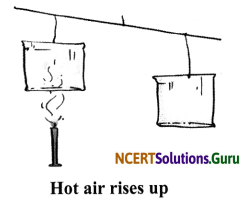
Question 5.
How does modern technology help us to predict cyclones in advance?
Answer:
Modem technology helps us in fol lowing ways:
- Satellites and radars helps in forecasting cyclones.
- Cyclone alert or cyclone watch is issued 48 hours in advance of any expected storm.
- Cyclone warning is issued 24 hours in advance.
- The message is broadcasted every hour or half an hour when cyclone is near the coast.
- Several national and international organisations cooperate to monitor the cyclone related disaster.
![]()
Question 6.
Describe the formation of a tornado.
Answer:
A tornado is a weather condition when a cloud having a dark funnel-shape reaches from the sky to the ground. The diameter of a tornado can range from one metre to several kilometres. The tornadoes can be formed within cyclones as well. In a tornado, winds blow at high speed of 300 km per hour.
The funnel-like shape of a tornado sucks everything that comes near it at the base because of the low pressure exerted by the winds. It then throws the things upwards. Hence, tornados can be devastating.
Picture-Based Questions
Question 1.
Figure shows a diagrammatic representation of trees in the afternoon along a sea coast. State on which side A or B is the sea located. Give reason for your choice.

Answer:
In the afternoon, the wind blows from sea to land as air pressure on the land is less than the pressure above the sea. Hence, the sea is on B side.
Question 2.
Look at the picture of a cyclone approaching the coast of Orissa. Write the dates of the cyclones.
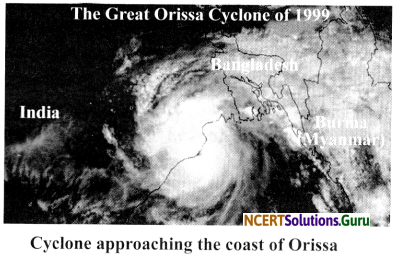
Answer:
a. Date of first cyclone: 18 October 1999.
b. Date of second cyclone: 29 October 1999.
![]()
Question 3.
Look at the following diagram and answer the following questions:
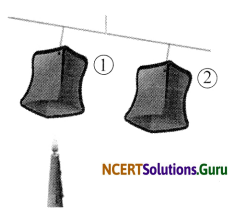
a. Which bag (1) or (2) contains hot air?
b. What does this activity show?
Answer:
a. Bag (1) contains hot air.
b. This activity shows that hot air is lighter and rises up.